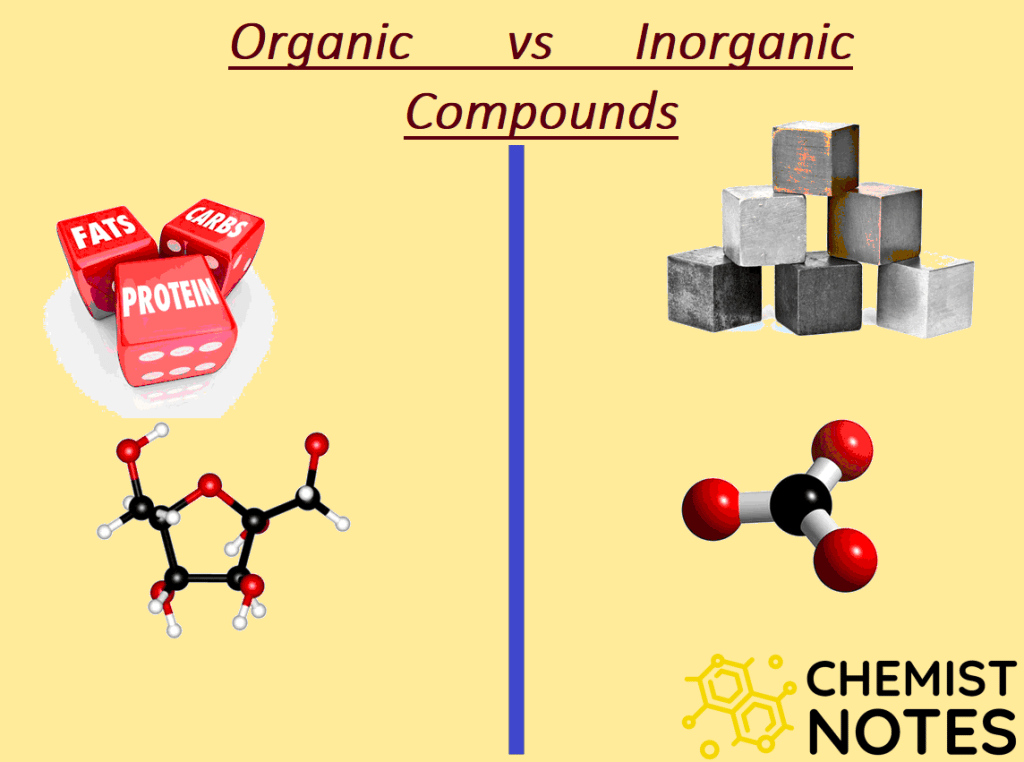Table of Contents
ToggleOrganic and inorganic compounds differ in many respects, including composition, origin, structure, and properties. Chemistry is a fundamental branch of science that deals with the composition, preparation, and properties of various substances. These substances are made of one or different compounds. There are two main classes of chemical compounds;
- Organic Compounds
- Inorganic Compounds

Definition
More than a century ago all substances then known were classified on the basis of the source from which they were derived. The compounds which were of mineral origin were known as inorganic and those of vegetables or animals were called organic. for example, table salt, marble, glass, alums, gypsums, blue vitriol, washing soda, baking soda, etc are inorganic compounds whereas carbohydratess, proteins, fats, vitamins, hormones, petroleum products, oils, etc are organic compounds. The classification of chemical compounds was very primitive in the history of chemistry which was given by the swedes chemist, J.J. Berzelius in the early 18th century.
Nowadays the definition of the organic and inorganic compounds is different in that the binary compound of carbon and hydrogen i.e. hydrocarbon and their derivative which directly and indirectly involve living matter are called organic compounds. For examples carbohydrate, proteins, fats, vitamins, hormones, petroleum products, drugs, dyes, plastics, gums, rubber, etc. are organic compounds whereas carbon monoxide, carbon dioxide, carbon disulphide, metal carbonates, metal cyanides, isocyanides, isocyanates, thiocyanates, etc are inorganic compounds.
Distinction between organic and inorganic compounds
| Property | Organic compounds | Property |
| Composition | Carbon is an essential element. | May be composed of any element. |
| Occurrence | The majority of compounds occur in living beings. | The majority of compounds occur in non-living matters. |
| Number | More than 5 million compounds are discovered. | About 1 lakh compounds were discovered. |
| Bonding | Posses covalent bonds. | Posses covalent, ionic, or co-ordinate bonds. |
| Catenation | Carbon atom forms long chains and rings by self-combination. | no element forms such long chains and rings. |
| Melting and Boiling point | Posses low melting points and boiling points. | Posses higher melting points and boiling points. |
| Solubility | Soluble in non-polar solvents. | Soluble in polar solvents. |
| Conductivity | Solutions are non-conductors of electricity. | Solutions are conductors of electricity. |
| Classification | Organic compounds are classified according to functional groups into different classes. | Inorganic compounds are broadly classified as acids, bases, and salts. |
| Homology | Posses homologous series. | Do not possess such homologous series. |
| Isomerism | Exhibit the phenomenon of isomerism. | Do not show isomerism. |
| Reactivity | Organic compounds show molecular reactions which are generally shown. | Inorganic compounds show ionic reactions which are very fast. |
| Combustibility | Undergo combustion to produce carbon dioxide, water, and energy. | Generally non-combustible and give variety of product on heating. |
FAQs
What is meant by organic compound?
The binary compounds of carbon and hydrogen i.e. hydrocarbon and their derivative which directly and indirectly involve living matter are called organic compounds.
How many inorganic compounds are there?
The number of inorganic compounds is approximately 1,00,000 and is not rapidly increasing.
What is the difference between organic and inorganic compounds?
The compounds which were of mineral origin were known as inorganic and those of vegetables or animals were called organic.






